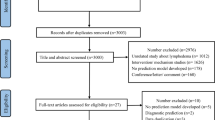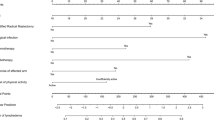Abstract
There are modifiable and non-modifiable risk factors associated with the onset of cancer treatment-related lymphedema. Identifying individual risk factors and prospectively monitoring those who are at risk for developing lymphedema is an evidence-based approach to enable early identification and treatment of lymphedema and may prevent the progression of the condition to a more chronic condition. The purpose of this chapter is to review the evidence for risk-reduction activities and to outline how a prospective surveillance model could enable improved detection and management of lymphedema in a clinical setting.
Access this chapter
Tax calculation will be finalised at checkout
Purchases are for personal use only
Similar content being viewed by others
References
Grada AA, Phillips TJ. Lymphedema: pathophysiology and clinical manifestations. J Am Acad Dermatol. 2017;77(6):1009–20.
Ridner SH. Pathophysiology of lymphedema. Semin Oncol Nurs. 2013;29(1):4–11.
Pfarr KM, Debrah AY, Specht S, Hoerauf A. Filariasis and lymphoedema. Parasite Immunol. 2009;31(11):664–72.
Shaitelman SF, Cromwell KD, Rasmussen JC, Stout NL, Armer JM, Lasinski BB, et al. Recent progress in the treatment and prevention of cancer-related lymphedema. CA Cancer J Clin. 2015;65(1):55–81.
Anand A, Balasubramanian D, Subramanian N, Murthy S, Limbachiya S, Iyer S, et al. Secondary lymphedema after head and neck cancer therapy: a review. Lymphology. 2018;51(3):109–18.
Mendivil AA, Rettenmaier MA, Abaid LN, Brown JV 3rd, Micha JP, Lopez KL, et al. Lower-extremity lymphedema following management for endometrial and cervical cancer. Surg Oncol. 2016;25(3):200–4.
Ki EY, Park JS, Lee KH, Hur SY. Incidence and risk factors of lower extremity lymphedema after gynecologic surgery in ovarian cancer. Int J Gynecol Cancer. 2016;26(7):1327–32.
Friedman JF, Sunkara B, Jehnsen JS, Durham A, Johnson T, Cohen MS. Risk factors associated with lymphedema after lymph node dissection in melanoma patients. Am J Surg. 2015;210(6):1178–84. discussion 84
Siegel RL, Miller KD, Jemal A. Cancer statistics, 2019. CA Cancer J Clin. 2019;69(1):7–34.
Rockson SG. The genetic predisposition to breast cancer-associated lymphedema. Mary Ann Liebert, Inc; 2019.
Byun HK, Chang JS, Im SH, Kirova YM, Arsene-Henry A, Choi SH, et al. Risk of lymphedema following contemporary treatment for breast cancer: an analysis of 7617 consecutive patients from a multidisciplinary perspective. Ann Surg. 2019;274(1):170–8.
McLaughlin SA, Brunelle CL, Taghian A. Breast cancer-related lymphedema: risk factors, screening, management, and the impact of locoregional treatment. J Clin Oncol. 2020;38(20):2341–50.
Rupp J, Hadamitzky C, Henkenberens C, Christiansen H, Steinmann D, Bruns F. Frequency and risk factors for arm lymphedema after multimodal breast-conserving treatment of nodal positive breast cancer – a long-term observation. Radiat Oncol. 2019;14(1):39.
Warren LE, Miller CL, Horick N, Skolny MN, Jammallo LS, Sadek BT, et al. The impact of radiation therapy on the risk of lymphedema after treatment for breast cancer: a prospective cohort study. Int J Radiat Oncol Biol Phys. 2014;88(3):565–71.
Carlson JW, Kauderer J, Hutson A, Carter J, Armer J, Lockwood S, et al. GOG 244-The lymphedema and gynecologic cancer (LEG) study: incidence and risk factors in newly diagnosed patients. Gynecol Oncol. 2020;156(2):467–74.
Kuroda K, Yamamoto Y, Yanagisawa M, Kawata A, Akiba N, Suzuki K, et al. Risk factors and a prediction model for lower limb lymphedema following lymphadenectomy in gynecologic cancer: a hospital-based retrospective cohort study. BMC Womens Health. 2017;17(1):50.
Hayes SC, Janda M, Ward LC, Reul-Hirche H, Steele ML, Carter J, et al. Lymphedema following gynecological cancer: results from a prospective, longitudinal cohort study on prevalence, incidence and risk factors. Gynecol Oncol. 2017;146(3):623–9.
Biglia N, Zanfagnin V, Daniele A, Robba E, Bounous VE. Lower body lymphedema in patients with gynecologic cancer. Anticancer Res. 2017;37(8):4005–15.
Todo Y, Yamazaki H, Takeshita S, Ohba Y, Sudo S, Minobe S, et al. Close relationship between removal of circumflex iliac nodes to distal external iliac nodes and postoperative lower-extremity lymphedema in uterine corpus malignant tumors. Gynecol Oncol. 2015;139(1):160–4.
Kunitake T, Kakuma T, Ushijima K. Risk factors for lower limb lymphedema in gynecologic cancer patients after initial treatment. Int J Clin Oncol. 2020;25(5):963–71.
Tribius S, Pazdyka H, Tennstedt P, Busch C-J, Hanken H, Krüll A, et al. Prognostic factors for lymphedema in patients with locally advanced head and neck cancer after combined radio (chemo) therapy-results of a longitudinal study. Oral Oncol. 2020;109:104856.
Deng J, Wulff-Burchfield EM, Murphy BA. Late soft tissue complications of head and neck cancer therapy: lymphedema and fibrosis. J Natl Cancer Inst Monogr. 2019;2019(53):lgz005.
Ridner SH, Dietrich MS, Sonis ST, Murphy B. Biomarkers associated with lymphedema and fibrosis in patients with cancer of the head and neck. Lymphat Res Biol. 2018;16(6):516–24.
Deng J, Ridner SH, Dietrich MS, Wells N, Wallston KA, Sinard RJ, et al. Factors associated with external and internal lymphedema in patients with head-and-neck cancer. Int J Radiat Oncol Biol Phys. 2012;84(3):e319–28.
Wu X, Liu Y, Zhu D, Wang F, Ji J, Yan H. Early prevention of complex decongestive therapy and rehabilitation exercise for prevention of lower extremity lymphedema after operation of gynecologic cancer. Asian J Surg. 2020;44(1):111–5.
Asdourian MS, Skolny MN, Brunelle C, Seward CE, Salama L, Taghian AG. Precautions for breast cancer-related lymphoedema: risk from air travel, ipsilateral arm blood pressure measurements, skin puncture, extreme temperatures, and cellulitis. Lancet Oncol. 2016;17(9):e392–405.
Ferguson CM, Swaroop MN, Horick N, Skolny MN, Miller CL, Jammallo LS, et al. Impact of ipsilateral blood draws, injections, blood pressure measurements, and air travel on the risk of lymphedema for patients treated for breast cancer. J Clin Oncol. 2016;34(7):691–8.
Armer JM, Hulett JM, Bernas M, Ostby P, Stewart BR, Cormier JN. Best-practice guidelines in assessment, risk reduction, management, and surveillance for post-breast cancer lymphedema. Curr Breast Cancer Rep. 2013;5(2):134–44.
McLaughlin SA, Stout NL, Schaverien MV. Avoiding the swell: advances in lymphedema prevention, detection, and management. Am Soc Clin Oncol Educ Book. 2020;40:e17–26.
Bland KL, Kosir MA. Improving the quality of life in breast cancer survivors at risk for lymphedema. Surgery. 2019;166(4):686–90.
Gillespie TC, Sayegh HE, Brunelle CL, Daniell KM, Taghian AG. Breast cancer-related lymphedema: risk factors, precautionary measures, and treatments. Gland Surg. 2018;7(4):379–403.
Hnin YK, Ong LX, Tsai CC, Ong SS, Yee SG, Choo BA, et al. Does initial routine use of a compression garment reduce the risk of lower limb lymphedema after gynecological cancer treatment? A randomized pilot study in an Asian institution and review of the literature. Lymphology. 2018;51(4):174–83.
Stout Gergich NL, Pfalzer LA, McGarvey C, Springer B, Gerber LH, Soballe P. Preoperative assessment enables the early diagnosis and successful treatment of lymphedema. Cancer. 2008;112(12):2809–19.
Li F, Lu Q, Jin S, Zhao Q, Qin X, Jin S, et al. A scoring system for predicting the risk of breast cancer-related lymphedema. Int J Nurs Sci. 2020;7(1):21–8.
Stout NL, Binkley JM, Schmitz KH, Andrews K, Hayes SC, Campbell KL, et al. A prospective surveillance model for rehabilitation for women with breast cancer. Cancer. 2012;118(S8):2191–200.
Chance-Hetzler J, Armer J, Van Loo M, Anderson B, Harris R, Ewing R, et al. Prospective lymphedema surveillance in a clinic setting. J Pers Med. 2015;5(3):311–25.
Lai L, Binkley J, Jones V, Kirkpatrick S, Furbish C, Stratford P, et al. Implementing the prospective surveillance model (PSM) of rehabilitation for breast cancer patients with 1-year postoperative follow-up, a prospective, observational study. Ann Surg Oncol. 2016;23(10):3379–84.
Rafn BS, Hung S, Hoens AM, McNeely ML, Singh CA, Kwan W, et al. Prospective surveillance and targeted physiotherapy for arm morbidity after breast cancer surgery: a pilot randomized controlled trial. Clin Rehabil. 2018;32(6):811–26.
Levenhagen K, Davies C, Perdomo M, Ryans K, Gilchrist L. Diagnosis of upper quadrant lymphedema secondary to cancer: clinical practice guideline from the Oncology Section of the American Physical Therapy Association. Phys Ther. 2017;97(7):729–45.
Ancukiewicz M, Russell TA, Otoole J, Specht M, Singer M, Kelada A, et al. Standardized method for quantification of developing lymphedema in patients treated for breast cancer. Int J Radiat Oncol Biol Phys. 2011;79(5):1436–43.
Purcell A, Nixon J, Fleming J, McCann A, Porceddu S. Measuring head and neck lymphedema: the “ALOHA” trial. Head Neck. 2016;38(1):79–84.
Yost KJ, Cheville AL, Weaver AL, Al Hilli M, Dowdy SC. Development and validation of a self-report lower-extremity lymphedema screening questionnaire in women. Phys Ther. 2013;93(5):694–703.
Doersam JK, Dietrich MS, Adair MA, Rhoten B, Deng J, Ridner SH. A comparison of symptoms among patients with head and neck or truncal lymphedema and normal controls. Lymphat Res Biol. 2019;17(6):661–70.
Mayrovitz HN, Mikulka A, Woody D. Minimum detectable changes associated with tissue dielectric constant measurements as applicable to assessing lymphedema status. Lymphat Res Biol. 2019;17(3):322–8.
Shah C, Vicini FA, Arthur D. Bioimpedance spectroscopy for breast cancer related lymphedema assessment: clinical practice guidelines. Breast J. 2016;22(6):645–50.
Author information
Authors and Affiliations
Corresponding authors
Editor information
Editors and Affiliations
Rights and permissions
Copyright information
© 2022 The Author(s), under exclusive license to Springer Nature Switzerland AG
About this chapter
Cite this chapter
Stout, N.L., Armer, J.M. (2022). Lymphedema Prospective Surveillance and Risk Reduction. In: Schaverien, M.V., Dayan, J.H. (eds) Multimodal Management of Upper and Lower Extremity Lymphedema. Springer, Cham. https://doi.org/10.1007/978-3-030-93039-4_4
Download citation
DOI: https://doi.org/10.1007/978-3-030-93039-4_4
Published:
Publisher Name: Springer, Cham
Print ISBN: 978-3-030-93038-7
Online ISBN: 978-3-030-93039-4
eBook Packages: MedicineMedicine (R0)




